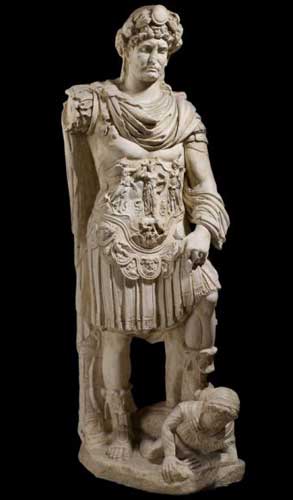Hadrian, British Museum, London
Two thousand years on, Hadrian's character shines in this biography of stone and metal

A few words of scene-setting might be handy, especially for those who spent the periods devoted to post-Augustan Rome staring out of the classroom window. The Emperor Hadrian – more formally, Publius Aelius Hadrianus (born AD76; ruled from 117 until his death in AD138) – has had a pretty good press across the centuries, except from historians of the Jews, who remember his savage crushing of a Jewish revolt much as Irish historians think of Cromwell's policies in Ireland. Machiavelli defined him as one of the "five good Emperors" – Nerva, Trajan, Hadrian, Antoninus Pius and Marcus Aurelius – whose successive periods of rule added up to a happy interval of moderation, reason and the rule of law amid the general nightmare of history.
Gibbon went still further, and said that under this sage quintet, "the Roman Empire was governed by absolute power, under the guidance of wisdom and virtue". Cynics might want to question just how wise and virtuous one had to be to qualify as a "good" emperor, when the competition includes mass-murdering headcases such as Caligula and Nero. Nonetheless, Hadrian has had many more admirers than detractors, especially since Marguerite Yourcenar's beautiful novel Memoirs of Hadrian (1951) helped extend his fan base well beyond the world of classicists. Privately, he seems to have been of a scholarly, philosophical cast; he wrote poetry and an autobiography (lost); he had strong visual tastes, and commissioned many works of art and architecture, some of them enduringly great.
But is it possible to detect those virtues in the man's carved face? Maybe. The very first object that strikes the eye as you enter the British Museum's Hadrian: Empire and Conflict is also its major coup – a yard-high bust of Hadrian, all but perfect save for some damage around the nose, unearthed in 2007, in Turkey. It's a powerful face – and would retain that power whether it were the image of a butcher or a police officer – and an intelligent one. This is the man in his prime, around his early forties: just a touch of fleshiness, which hints at the pleasures of the table; neatly coiffed hair, curling in on itself like cream on a gateau, and a trim beard (the expression of his passionate admiration for all things Greek. Earlier emperors, such as Augustus, were clean-shaven).
This elegant, thoughtfully staged show is rich in portraits of the man, and, put together, they amount to a biography in stone and metal. With his dashing sideburns and luxuriant curls, the young Hadrian looks eerily similar to portraits of Pushkin. In later years, rather more bulked up, he can seem either an affable man of the world – a Peter Ustinov type, mirthful anecdotes rising to the lip – or a raptor-eyed general: a chilly friend, a terrifying enemy. What is most striking about all these portraits is how seldom they read as mere state propaganda: the best of them are all psychologically plausible, and include a strange and haunting detail – a mark on Hadrian's earlobe which, medical science can now tell us, may be a symptom of a chronic heart condition.
If there is anything to be faulted in an exhibition which otherwise treads an admirably judicious path between offending its audience with too much basic information and starving it with too little, it is precisely this strong concentration on the personal dimension. By the time you have meandered through its dozen or so sections, you will have learned or been reminded of many things about Hadrian's personal life: his homosexual love for Antinous; his cool, dutiful marriage to the wife chosen for him by Trajan; three phases of his passion for building – the Pantheon, the extraordinary villa at Tivoli, and his Mausoleum, complete with a brace of splendid bronze peacocks. The wittiest stroke comes in a series of photographs illustrating the long-term influence of the Pantheon's design on Brunelleschi, on Albert Speer ... and on the dome of the British Museum. If you seek his monument, bend your neck.
What is less abundantly documented is the part of Hadrian's story which usually engages historians: the "Empire and Conflict" aspect. This theme is tucked away in a couple of early sections, one devoted to the series of revolts he inherited from Trajan, and another to the edifice for which he is best known in Britannia, the large coast-to-coast wall across northern England. Fine in their way, though likely to be appreciated in direct proportion to the amount of prior learning the visitor brings.
But this is a negligible flaw in a handsome show which allows the strange privilege of confronting a mind (and a face) that remains compelling after 2,000 years. It ends with Hadrian's deathbed poem – Animula vagula blandula – about the "little soul" taking leave of its bodily home. If it does not move you, your heart is stonier than Hadrian's bust.
To 26 Oct (020-7323 8181)
Join our commenting forum
Join thought-provoking conversations, follow other Independent readers and see their replies
0Comments